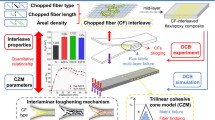Abstract
In this research, unidirectional flax fabrics reinforced epoxy laminates were interleaved with randomly oriented chopped flax yarns at various yarn lengths and contents. Mode I interlaminar fracture toughness of the laminates was evaluated via Double Cantilever Beam (DCB) tests. The results showed that Mode I interlaminar fracture toughness increased with the introduction of the chopped yarns. With moderate yarn length and content, the best toughening effect (31% improvement in Mode I interlaminar fracture toughness) was achieved. It was observed with the aid of Scanning Electronic Microscopy (SEM) that the introduction of the chopped yarns resulted in more tortuous in-plane crack propagation paths as well as the “trans-layer” phenomenon and fiber bridging effect of both the unidirectional yarns and the chopped yarns. These hindered the growth of the crack and led to more energy dissipation during delamination progress. Excessive yarn length or content would induce unstable crack propagation and thus weakened the toughening improvement. No remarkable change was found in the tensile properties and the Charpy impact strength for the interleaved laminates, which indicated that this interleaving method was effective on interlaminar toughening without sacrificing the comprehensive mechanical properties of the laminates.
Similar content being viewed by others
References
Joshi S V, Drzal L, Mohanty A, et al. Are natural fiber composites environmentally superior to glass fiber reinforced composites? Compos Part A-Appl S, 2004; 35: 371–376
Netravali A N, Chabba S. Composites get greener. Mater Today, 2003; 6: 22–29
Takagi H, Kako S, Kusano K, et al. Thermal conductivity of PLA-bamboo fiber composites. Adv Compos Mater, 2007; 16: 377–384
Yang W, Li Y. Sound absorption performance of natural fibers and their composites. Sci China Tech Sci, 2012; 55: 2278–2283
Li Y, Luo Y, Han S. Multi-scale structures of natural fibres and their applications in making automobile parts. J Biobased Mater Bio, 2010; 4: 164–171
Pritchett I. Hemp and lime composites in sustainable construction. In: Proceedings of the 11th International Conference on Non-conventional Materials and Technologies (NOCMAT 2009), Bath, 2009. 6–9
Wambua P, Ivens J, Verpoest I. Natural fibres: can they replace glass in fibre reinforced plastics? Compos Sci Technol, 2003; 63: 1259–1264
Li Y, Luo Y. Mechanical properties and applications of natural fiber reinforced composites. Acta Mech Solida Sin, 2010; 31: 613–630
Li X, Tabil L G, Panigrahi S. Chemical treatments of natural fiber for use in natural fiber-reinforced composites: a review. J Polym Environ, 2007; 15: 25–33
Mouritz A. Review of z-pinned composite laminates. Compos Part A-Appl S, 2007; 38: 2383–2397
Rong M Z, Zhang M Q, Liu Y, et al. Effect of stitching on in-plane and interlaminar properties of sisal/epoxy laminates. J Compos Mater, 2002; 36: 1505–1526
Mouritz A, Bannister M, Falzon P, et al. Review of applications for advanced three-dimensional fibre textile composites. Compos Part A-Appl S, 1999; 30: 1445–1461
Sohn M S, Hu X Z. Delamination behaviour of carbon fibre/epoxy composite laminates with short fibre reinforcement. Scripta Metall Mater, 1994; 30: 1467–1472
Sohn M S, Hu X Z. Processing of carbon-fibre/epoxy composites with cost-effective interlaminar reinforcement. Compos Sci Technol, 1998; 58: 211–220
Park B, Kim S C. A study of the interlaminar fracture toughness of a carbon-fiber/epoxy composite containing surface-modified short kevlar fibers. Compos Sci Technol, 1998; 58: 1599–1606
Yadav S, Kumar V, Verma S K. Fracture toughness behaviour of carbon fibre epoxy composite with Kevlar reinforced interleave. Mat Sci Eng B-Solid, 2006; 132: 108–112
Yasaee M, Bond I, Trask R, et al. Mode I interfacial toughening through discontinuous interleaves for damage suppression and control. Compos Part A-Appl S, 2012; 43: 198–207
Yasaee M, Bond I, Trask R, et al. Mode II interfacial toughening through discontinuous interleaves for damage suppression and control. Compos Part A-Appl S, 2012; 43: 121–128
Li Y M, Liu J, Huang B Z. Effect of short chopped fibers on mode i delamination toughness. J Northeast Univ, 2002, 11: 028
Huang B Z, Hu X Z, Liu J. Modelling of inter-laminar toughening from chopped Kevlar fibers. Compos Sci Technol, 2004, 64: 2165–2175
Zhang Y, Li Y, Ma H, et al. Tensile and interfacial properties of unidirectional flax/glass fiber reinforced hybrid composites. Compos Sci Technol, 2013; 88: 172–177
Johnson W S, Mangalgiri P. Investigation of fiber bridging in double cantilever beam specimens. DTIC Document, 1986
de Morais A. A new fibre bridging based analysis of the double cantilever beam (DCB) test. Compos Part A-Appl S, 2011, 42: 1361–1368
Saheb D N, Jog J. Natural fiber polymer composites: A review. Adv Polym Tech, 1999; 18: 351–363
Pinto M A, Chalivendra V B, Kim Y K, et al. Effect of surface treatment and Z-axis reinforcement on the interlaminar fracture of jute/epoxy laminated composites. Eng Fract Mech, 2013; 114: 104–114
Author information
Authors and Affiliations
Corresponding author
Rights and permissions
About this article
Cite this article
Li, Y., Wang, D. & Ma, H. Improving interlaminar fracture toughness of flax fiber/epoxy composites with chopped flax yarn interleaving. Sci. China Technol. Sci. 58, 1745–1752 (2015). https://doi.org/10.1007/s11431-015-5911-3
Received:
Accepted:
Published:
Issue Date:
DOI: https://doi.org/10.1007/s11431-015-5911-3




